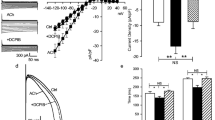Summary
Outwardly rectifying swelling-activated chloride conductance (ICl,Swell) in rabbit heart plays a critical role in cardioprotection following ischemic preconditioning (IP). But the functional characterization and molecular basis of this chloride conductance in rabbit heart ventricular myocytes is not clear. Candidate chloride channel clones (e.g. ClC-2, ClC-3, ClC-4 and ClC-5) were determined using RT-PCR and Western blot analysis.Whole cell ICl,Swell was recorded from isolated rabbit ventricular myocytes using patch clamp techniques during hypo-osmotic stress. The inhibitory effects of 4,4′ isothiocyanato-2,2-disulfonic acid (DIDS), 5-nitro-2(3-phenylroylamino) benzoic acid (NPPB) and indanyloxyacetic acid 94 (IAA-94) on ICl,Swell were examined. The expected size of PCR products for ClC-2, ClC-3 and ClC-4 but not for ClC-5 was obtained. ClC-2 and ClC-3 expression was confirmed by automated fluorescent DNA sequencing. RT-PCR and Western blot showed that ClC-4 was expressed in abundance and ClC-2 was expressed at somewhat lower levels. The biological and pharmacological properties of ICl,Swell, including outward rectification, activation due to cell volume change, sensitivity to DIDS, IAA-94 and NPPB were identical to those known properties of ICl,Swell in exogenously expressed systems and other mammals hearts. It was concluded that ClC-3 or ClC-4 might be responsible for the outwardly rectifying part of ICl,Swell and may be the molecular targets of cardioprotection associated with ischemic preconditioning or hypo-osmotic shock.
Similar content being viewed by others
References
Baumgarten C M, Clemo H F. Swelling-activated chloride channels in cardiac physiology and pathophysiology. Prog Biophys Mol Biol, 2003,82(1–3):25–42
Bahinski A, Naim A C, Greengard P et al. Chloride conductance regulated by cyclic AMP-dependent protein kinase in cardiac myocytes. Nature, 1989,340:718–721
Zygmunt A C, Gibbons W R. Calcium-activated chloride current in rabbit ventricular myocytes. Circ Res, 1991,68:424–437
Zygmunt A C, Gibbons W R. Properties of the calcium-activated chloride current in heart. J Gen Physiol, 1992,99:391–414
Tseng G N. Cell swelling increase membrane conductance of canine cardiac cells: evidence for a volume-sensitive Cl− channel. Am J Physiol, 1992,262:C1056–C1067
Sorota S. Swelling-induced chloride-sensitive chloride in dog atrial cells revealed by whole cell patch clamp method. Circ Res, 1992,70:679–687
Duan D Y, Liu L L, Bozeat N et al. Functional role of anion channels in cardiac diseases. Acta Pharmacol Sin, 2005,26(3):265–278
Diaz R J, Losito V A, Mao G D et al. Chloride channel inhibition blocks the protection of ischemic preconditioning and hypo-osmotic stress in rabbit ventricular myocardium. Circ Res, 1999,84:763–775
Duan D, Ye L, Britton F et al. A novel anionic inward rectifier in native cardiac myocytes. Circ Res, 2000,86:e63–e71
Jentsch T J, Günther W. Chloride channels: an emerging molecular picture. Bioassays, 1992,360:759–762
Diaz R J, Zobel C, Cho H C et al. Selective inhibition of inward rectifier K+ channels (Kir2.1 or Kir2.2) abolishes protection by ischemic preconditioning in rabbit ventricular cardiomyocytes. Circ Res, 2004,95(3):325–332
Hamill O P, Marty A, Neher B et al. Improved patch-clamp technique for high-resolution current recording from cells and cell-free membrane patched. Pflügers Arch, 1981,391:85–100
Du X Y, Sorota S. Cardiac swelling-induced chloride current depolarizes canine atrial myocytes. Am J Physiol, 1997,272:H1904–H1916
Horowitz B, Tsung S S, Hart P et al. Alternative splicing of CFTR Cl-channels in heart. Am J Physiol, 1993,264:H2214–H2220
Sorota S. Pharmacological properties of the swelling-induced chloride current of dog atrial myocytes. J Cardiovasc Electrophysiol, 1994,5:1006–1016
Vandenberg J I, Yoshida A, Kirk K et al. Swelling-activated and isoprenaline-activated chloride currents in guinea pig cardiac myocytes have distinct electrophysiology and pharmacology. J Gen Physiol, 1994,104:997–1017
Walsh K B, Wang C. Effect of chloride channel blockers on the CFTR chloride and L-type calcium currents. Cardiovasc Res, 1996,32:391–399
Gründer S, Theimann A, Pusch M et al. Regions involved in the opening of ClC-2 chloride channel by voltage and cell volume. Nature, 1992,360:759–762
Diaz R J, Li J D, Batthish M et al. Inward rectifier K+ channel (IK1) inhibition abolishes the protection of ischemic preconditioning against cell death caused by ischemia reperfusion injury in rabbit cultured myocytes. Upstate New York Cardiac Electrophysiology Society 9th Annual Meeting, Masonic Temple University, Utica, NY, October 22, 1999. Abstract
Additional information
Jingdong LI, male, born in 1962, Associate Professor
This project was supported by a grant from Chinese Ministry of Education for Returning Overseas Scholars.
Rights and permissions
About this article
Cite this article
Li, J., Wu, X. & Cui, T. Functional characteristics and molecular identification of swelling-activated chloride conductance in adult rabbit heart ventricles. J. Huazhong Univ. Sci. Technol. [Med. Sci.] 28, 37–41 (2008). https://doi.org/10.1007/s11596-008-0109-6
Received:
Issue Date:
DOI: https://doi.org/10.1007/s11596-008-0109-6




